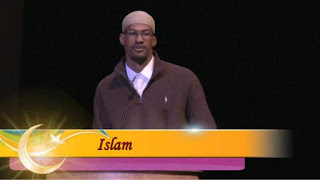Park51 “Ground Zero Mosque” - In Context
Written By Taj Ashaheed
Much of what characterizes the issue of the “Park51” community center or the commonly referred "Ground Zero Mosque" is misunderstood or unexamined context. From the start of the controversy, it was clear as the community center was generalized in the media as a mosque and touted as being built at Ground Zero (as opposed to its actual location) that opponents of the center and the media itself were complicit in crafting a position that was both narrow in mind and critical thought.
Indeed the current controversy of Park51 is an excellent study of where we as a national community can find some true insight and even understanding if looked at it from a wider scope.
Opponents of the community center rally around the presumption that Park51 and its attached mosque is an affront to the victims of September 11th; however, this generalization is troublesome as it ignores the fact that among the families of the victims are those who are Muslim. Indeed, it is estimated that several hundred of the victims at the World Trade Center were Muslim, with nearly 100 of them being identified as such. It is clear that opinions about Park51 vary among the Muslim family members, but to generalize them ass among those who are insulted by its proposal is irresponsible.
Opponents of the community center would have you think that the sanctity of Ground Zero demands it be purified of Islam's presence or influences. This position, too, fails when examining more context. For example, Minoru Yamasaki, the lead architect for the World Trade Center, was deliberate in designing the Towers and complex using Islamic architectural design elements, from the face of the tower's repeated arch design to the garden courtyard which was copied from designs of the holy city of Mecca, to the actual design of the towers themselves representing minarets.
The connection to Islam goes deeper... literally: Ground Zero, and it's surrounding areas, sits atop the graves of 20,000 African slaves --- approximately 5,000 of whom were Muslim. Historically, slaves were not permitted to be buried in New York City itself, thus the outlying areas, present-day site of Ground Zero and beyond, were used as slave cemeteries. Recent excavations, just one block away from Ground Zero, yielded the remains of slaves who lived and toiled in 17th-century New Amsterdam, which later became New York City. This fact alone, makes the touted "sacred ground" adjective of Ground Zero ironic indeed.
Then, there is the question of Park51's vicinity. Why, opponents ask, can't organizers be sensitive and choose a more distant site? This question, and its implied discrimination, is rendered moot by the fact that there are already mosques in the vicinity of Ground Zero. Masjid Manhattan ... built 40 years ago before the World Trade Center broke ground ... is situated just four blocks away and has Muslim congregants who are federal and city employees and who work in the financial arena, including the WTC prior to 9/11. Masjid Al Farah, a Sufi mosque, sits about 10 blocks away. Al Farah, built 25 years ago, can be found on West Broadway.
Looked at from a broader perspective, it is easy to see how opposition to Park51 is thinly veiled in hate and anger; and just how much of a role these emotions play in how our nation gives consideration to Islam and to Muslims. As the debate over Park51 rages on, and as anti-Muslim sentiment grows alarmingly in the United States, the encouragement to take a second and/or deeper look at the root of Muslim-American issues and even more importantly, to the peripheral, will become more and more key in creating opportunities for healing, bridge building, and mutual respect for all involved.
Much of what characterizes the issue of the “Park51” community center or the commonly referred "Ground Zero Mosque" is misunderstood or unexamined context. From the start of the controversy, it was clear as the community center was generalized in the media as a mosque and touted as being built at Ground Zero (as opposed to its actual location) that opponents of the center and the media itself were complicit in crafting a position that was both narrow in mind and critical thought.
Indeed the current controversy of Park51 is an excellent study of where we as a national community can find some true insight and even understanding if looked at it from a wider scope.
Opponents of the community center rally around the presumption that Park51 and its attached mosque is an affront to the victims of September 11th; however, this generalization is troublesome as it ignores the fact that among the families of the victims are those who are Muslim. Indeed, it is estimated that several hundred of the victims at the World Trade Center were Muslim, with nearly 100 of them being identified as such. It is clear that opinions about Park51 vary among the Muslim family members, but to generalize them ass among those who are insulted by its proposal is irresponsible.
Opponents of the community center would have you think that the sanctity of Ground Zero demands it be purified of Islam's presence or influences. This position, too, fails when examining more context. For example, Minoru Yamasaki, the lead architect for the World Trade Center, was deliberate in designing the Towers and complex using Islamic architectural design elements, from the face of the tower's repeated arch design to the garden courtyard which was copied from designs of the holy city of Mecca, to the actual design of the towers themselves representing minarets.
The connection to Islam goes deeper... literally: Ground Zero, and it's surrounding areas, sits atop the graves of 20,000 African slaves --- approximately 5,000 of whom were Muslim. Historically, slaves were not permitted to be buried in New York City itself, thus the outlying areas, present-day site of Ground Zero and beyond, were used as slave cemeteries. Recent excavations, just one block away from Ground Zero, yielded the remains of slaves who lived and toiled in 17th-century New Amsterdam, which later became New York City. This fact alone, makes the touted "sacred ground" adjective of Ground Zero ironic indeed.
Then, there is the question of Park51's vicinity. Why, opponents ask, can't organizers be sensitive and choose a more distant site? This question, and its implied discrimination, is rendered moot by the fact that there are already mosques in the vicinity of Ground Zero. Masjid Manhattan ... built 40 years ago before the World Trade Center broke ground ... is situated just four blocks away and has Muslim congregants who are federal and city employees and who work in the financial arena, including the WTC prior to 9/11. Masjid Al Farah, a Sufi mosque, sits about 10 blocks away. Al Farah, built 25 years ago, can be found on West Broadway.
Looked at from a broader perspective, it is easy to see how opposition to Park51 is thinly veiled in hate and anger; and just how much of a role these emotions play in how our nation gives consideration to Islam and to Muslims. As the debate over Park51 rages on, and as anti-Muslim sentiment grows alarmingly in the United States, the encouragement to take a second and/or deeper look at the root of Muslim-American issues and even more importantly, to the peripheral, will become more and more key in creating opportunities for healing, bridge building, and mutual respect for all involved.



Comments
Well put, brother. Well put. As it is said, "when truth is exposed, falsehood perishes..."